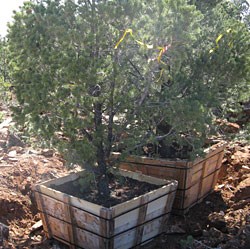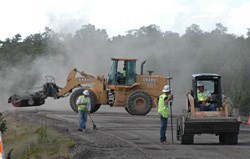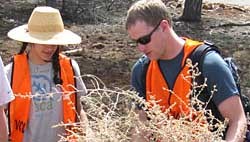Native Plant Restoration at the S. Rim Visitor CenterBy Allyson Mathis, Lori Makarick and Jan Busco 
Preserving native vegetation is an integral part of the National Park Service’s mission at Grand Canyon National Park. Every construction project in the park, such as the improvement in visitor facilities at Mather Point and the Grand Canyon Visitor Center, is designed to minimize impacts on the park’s plants and incorporates vegetation restoration work at its completion. 
Each restoration project begins with a complete survey of the existing plant populations. Biologists from the park’s Division of Science and Resource Management identified trees, shrubs and grasses that could be salvaged to later be replanted at the end of the project. 
Once construction is completed and these trees are replanted, they will give the landscape a natural appearance and help speed the recovery of the surrounding vegetative community. Crews, with the help of volunteers, collected seeds from 50 species of native plants and salvaged more than 5000 plants prior to the start of construction. Read more... 
The park native plant nursery and the National Resource Conservation Service used these seeds to grow 23,000 trees, shrubs, wildflowers and grasses to be planted as part of the restoration of the site. Using seed only from local plants maintains the genetic integrity of Grand Canyon’s plant populations. 
Spreading this soil in restoration areas will jump start the reestablishment of healthy soil and plant communities and speed the recovery process. 
Construction projects provide a great environment for these species to gain a foothold in the park because of their ability to aggressively invade disturbed areas. 
Invasive plant control will continue after the construction is complete to ensure that native plant populations are established in restoration areas. 
Major planting along roads, parking lots and foot paths in the Mather Point and Grand Canyon Visitor Center area should be finished by early December 2009. An additional phase of restoration work will begin in January 2010 with the removal of the parking lot at Mather Point. When the project is completed, visitors will be able to experience native vegetation throughout the area. Vegetation program managers hope to replicate the success of the 2008 Hermit Road rehabilitation in which visitor facilities were greatly improved and the native vegetation was restored with more than 95% of plantings surviving. How You Can Be InvolvedThe Grand Canyon National Park is looking for willing volunteers to assist in the vegetation restoration aspect of the Grand Canyon Visitor Center Improvements Project, as well as in other projects, including the recently rehabilitated Hermit Road and Desert View entrance station. 
nps photo by Michael Quinn |
Last updated: April 30, 2023
